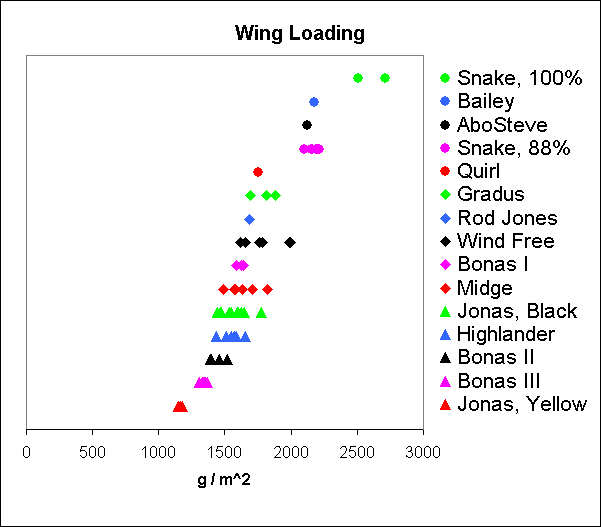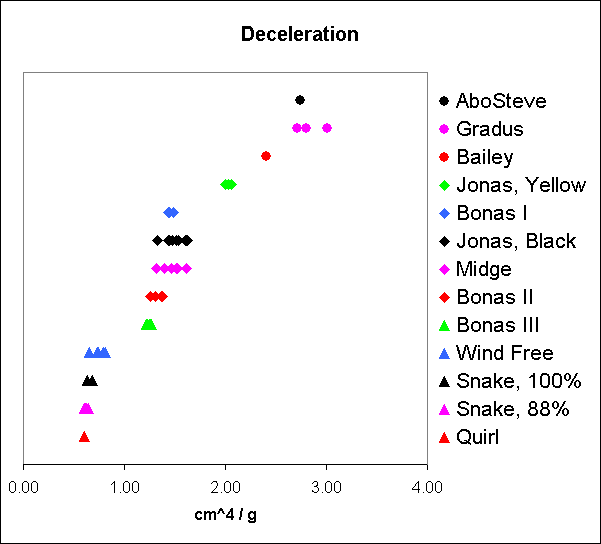What's this all about?
While I was at the 2001 Nationals I took advantage
of the opportunity to gather some data on mtas. I
measured booms from Gary Broadbent, Chet Snouffer,
Nobu, Jason Smucker, and a lot more. In all, a
total of 65 booms.
I didn't gather the data with the expectation that I
would be able to develop any kind of comprehensive
model of how an mta works. My hope was that in looking
at the data it might be possible to compare different
designs and identify some general patterns.
You know that old saying: "What goes up, must come
down"? I think it touches on two factors that are
important to mta performance. One is how far they go
up, the other is how slow they come down. Let's start
with looking at how slow they come down.
Wing Loading
Everything else being equal, a heavier boomerang will
descend faster and a lighter boomerang will descend
slower. If you're comparing two boomerangs of the
same design that have been optimally tuned, all you
have to look at is weight. But if you're comparing
two different designs, how do you take into account
their different sizes?
Wing loading is the amount of weight per unit area of
wing. Everything else being equal, a boomerang
with a higher wing loading will descend faster, and
a boomerang with a lower wing loading will descend
slower. Wing loading allows us to compare different
designs to see how well they "float" relative to one
another.
In order to gather the data necessary to calculate wing
loadings, I traced outlines of each design on quadrille
graph paper and then counted the squares to estimate the
area. This only needs to be done once for a given design,
but different boomerangs of the same design aren't identical
in weight, so each boomerang of a given design is weighed.
The following table contains a summary of the collected data.
For each design it lists: the material used, the range of weights
observed, and the wing area.
| Design |
Material |
Weight (grams) |
Area (square cm) |
| Wind Free |
Composite |
12.5 to 15.5 |
77.4 |
| Quirl |
Phenolic |
16.5 |
94.2 |
| Gradus |
Composite |
16.5 to 18.3 |
97.4 |
| Midge |
Composite |
14.8 to 18.1 |
99.3 |
| Highlander |
Composite |
14.7 to 17.0 |
102.6 |
| Snake, 88% |
Phenolic |
23.0 to 24.3 |
109.7 |
| Bonas I |
Composite |
18.4 to 19.0 |
116.1 |
| Bonas II |
Composite |
16.1 to 17.6 |
116.1 |
| Bonas III |
Composite |
15.2 to 15.9 |
116.1 |
| Jonas, Black |
Composite |
16.8 to 20.6 |
116.1 |
| Jonas, Yellow |
Composite |
13.3 to 13.7 |
116.1 |
| Rod Jones |
Plywood |
20.5 |
121.9 |
| Snake, 100% |
Phenolic |
33.2 to 35.9 |
132.2 |
| AboSteve |
Plywood |
35.7 |
168.3 |
| Bailey |
Plywood |
38.0 |
174.8 |
The next step is to divide the weights measured for
each design by the area for the design. The results
are graphed below. Lower numbers indicate a boomerang
that comes down slower.

The graph seems to roughly correlate with my observations,
which leads me to believe that this is a useful first-order
approximation of how slowly a boomerang floats down. There
are probably some variations, and I wouldn't use it for any
kind of absolute ranking, but the general trend seems clear:
booms with lower wing loadings float better.
Note that just because a boom has a higher wing loading does
not make it a poor choice. This is just one dimension of what
goes into the overall performance. Both small and large snakes
have high wing loadings, but they certainly see their share of
air time at tournaments. This brings us to the other factor:
how far they go up.
Deceleration
One of the factors that bears on how high an mta will
go is how fast it slows down. Booms that decelerate
quickly don't climb as long as those which decelerate
slowly, so they don't get a shot at as much height.
From physics we know that F = ma. What we're interested
in is the (negative) acceleration of the boom, so if we
divide the force of drag slowing the boom down by its
weight we end up with something that relates to how
fast the boom decelerates.
I'm assuming that the biggest contributor to the
deceleration of the boom is profile drag, so that's
all we'll look at here. To determine profile drag,
we need to know the average frontal surface area exposed
to the oncoming airflow. I measured the maximum width,
minimum width, and thickness of each design. I took
the average of the widths and multiplied by the thickness
to obtain an estimate of the frontal surface area. The
following table lists the results.
| Design |
Max Width (cm) |
Min Width (cm) |
Thickness (cm) |
Area (cm^2) |
| Quirl |
27.4 |
14.7 |
.150 |
3.16 |
| Wind Free |
29.4 |
13.0 |
.150 |
3.18 |
| Snake, 88% |
31.5 |
13.6 |
.170 |
3.83 |
| Bonas III |
36.7 |
15.6 |
.168 |
4.39 |
| Bonas II |
36.7 |
15.6 |
.180 |
4.71 |
| Snake, 100% |
35.1 |
15.0 |
.190 |
4.76 |
| Midge |
33.8 |
15.0 |
.200 |
4.88 |
| Jonas |
36.7 |
15.6 |
.200 |
5.23 |
| Bonas I |
36.7 |
15.6 |
.200 |
5.23 |
| Gradus |
33.3 |
12.9 |
.305 |
7.05 |
| Bailey |
42.1 |
18.1 |
.318 |
9.56 |
| AboSteve |
42.8 |
17.1 |
.330 |
9.89 |
I read somewhere that drag is proportional to the square
of the frontal surface area (can anyone confirm this?).
The next step is to divide the square of the frontal area
for each design by the range of weights measured for that
design. The resulting values relate to how quickly the booms
decelerate. Higher numbers slow down faster than lower
numbers. The results are graphed below.

Again, the graph seems to roughly correlate with my observations,
which leads me to believe that this is a useful first-order
approximation of the rate at which a boom decelerates. The booms
I see go farthest out and highest are all at the left end of the
graph. The general trend seems clear: booms which decelerate
slower achieve higher heights.
Side note: doing this graph with LD designs would be interesting.
Conclusions
The deceleration graph explains why, even though they have some
of the highest wing loadings, snakes are so prevelent in competition.
They simply have more "punch" than almost every other boom, so they
get a lot of height and distance out in front. They may come down
faster, but they start off higher up as well. The quirl is about
the same in this category, but has lower wing loading, so one would
expect snakes and quirls to get similar height, but quirls to come
down slower.
It's worth noting here that just because a boom decelerates quickly
doesn't mean it's a poor choice. Booms that decelerate quickly
are going to "damp out" the effects of a bad throw more than ones
that decelerate slowly. In competition, where you have a limited
number of throws, having a boom that'll forgive your mistakes may
be more important than more height.
I think a combination of factors makes the Jonas and Bonas booms
so popular in competition. They have low wing loading, so they
make good use of whatever lift is present, and due to their rate
of deceleration they don't require a perfect throw, which makes
them reliable for a broad range of throwers.

